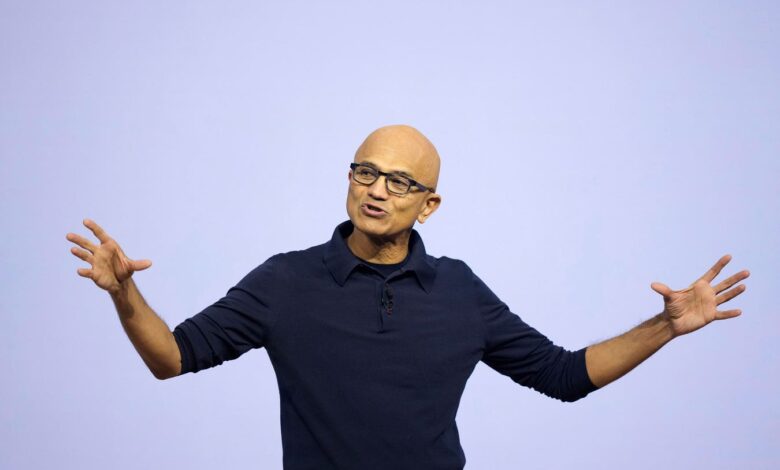How Microsoft Transitioned To Value Creation

📝 usncan Note: How Microsoft Transitioned To Value Creation
Disclaimer: This content has been prepared based on currently trending topics to increase your awareness.
Microsoft CEO Satya Nadella addresses Microsoft Ignite conference Nov. 19, 2024 in Chicago. (AP Photo/Charles Rex Arbogast)
Copyright 2024 The Associated Press. All rights reserved
In the 2000s, Microsoft under Steve Ballmer was a profit-focused hierarchy with a cutthroat culture, siloed empires, and a myopic obsession with milking Windows and Office for every last dollar. Innovation? Stagnant. Growth? Anemic. The company squandered opportunities, watching rivals like Apple and Google eat its lunch.
Today: under CEO Satya Nadella, Microsoft boasts a $3.75 trillion market cap and its 5-year total return is still growing faster than the S&P500 average. Nadella’s relentless customer-first mantra as CEO gets a lot of the credit. But let’s be real— the seeds of this value-creation overhaul were planted years before Nadella took the reins. Critics who see it as CEO miracle ignore the gritty, bottom-up transition that paved the way.
2008: The Wake-Up Call That Exposed Microsoft’s Rot
Back in 2008, the storm clouds were gathering. The future CEO Satya Nadella, then in charge of search, looked around and was shocked to find that Microsoft was way behind firms like Google. He explains in his book, Hit Refresh, set out learn how they were able to grow so rapidly—”how they engineered their products to stay fresh.” He discovered that “the key was agility, agility, agility. We needed to develop speed, nimbleness, and athleticism to get the consumer experience right, not just once but daily.”
He was not alone. Take Aaron Bjork, a young developer who had just launched a product only to discover a rival firm had done something similar three years before. Bjork didn’t complain—he experimented. He could see that if Microsoft continued as it was, it would die. Without permission, he and his team abandoned Microsoft’s standard bureaucratic processes and instead gave agile philosophy and methods a try: customer-focused sprints, rapid iterations, and a relentless focus on value ahead deadlines.
Bjork thrived on the chaos: “I love popping the hood, getting my hands dirty.
tweaking details that matter to users.” But the real key? Changing mindsets. The first year was brutal— a messy mix of wins, flops, and resistance. Teams struggled to finish sprints fully. Fix it or nix it. Self-testing, documentation— all owned by the team. It felt alien, disruptive, even reckless. “For many, it upended everything,” Bjork admitted. Yet, after a year of grinding, it had become embedded in the team’s DNA.
His role? Brutal honesty: Listen to customers, build what they need (not just want), sell it smartly, and own decision for what gets cut. This wasn’t fluffy idealism—it was survival. Success built momentum: other teams decided to give agile a try.
2009-2011: Rebellion Spreads, Top Brass Plays Catch-Up
It worked. By 2009, agile pockets began erupting across Microsoft. Momentum built. 2010 saw 25 teams go full agile, syncing on three-week sprints. Success screamed loud. By 2011, the entire Developer Division flipped. This wasn’t sanctioned —it was mid-level insurgency, transforming parts of the supertanker into fleets of nimble speedboats.
By 2013, leadership chatter shifted from skepticism to envy—”How do we get what they’re getting?”
2014: Nadella Takes Charge—But Don’t Call It a Miracle
So, when Nadella became CEO in February 2014, he had lived the value creation gospel for years. Yet skepticism persisted. An insider shaking up the status quo? Doomed. As late as 2015, a pundit like Geoffrey Moore was still writing in his book Zone To Win that Microsoft had “run out of steam.”
They were wrong. What they missed was the transformation that had already taken hold in the middle of the firm for six years, long before Nadella became CEO: these were the champions that Nadella drew on to take the revolution firm-wide.
Nadella embedded value creation into Microsoft’s DNA. Today, Microsoft is a titan: a huge fast-growing, grappling with the challenge of AI.
The Lessons?
Let’s dissect the lessons of the transition, which began long before Nadella became CEO.
- Bottom-Up Beats Waiting for Permission: For six years, agile was grassroots rebellion. Top-down mandates? Overrated. But it exposed leadership’s inertia—why did it take so long for them to wake up?
- Insiders Can Disrupt—If Battle-Tested: Nadella rose from agile strongholds, proving internal talent trumps visiting consultants.. Flaw? His early efforts (like Bing) continued to struggle, showing that even visionaries stumble.
- Change Is a Marathon, Not a Sprint: Since 2008, it’s evolved nonstop. Kudos for persistence, but slam the leadership dithering.
- Mindset Trumps Mechanics: Ditch process jargon; prioritize trust, results, and customer obsession. Weakness: Bureaucracy can re-emerge in new products like Teams.
- AI: The Next Make-or-Break Battleground: Nadella is betting big on AI for value creation. Smart pivot, but risky—over-hyping it could backfire. Stakes? Existential.
Today, Nadella is the CEO of one of the world’s most valuable and fastest-growing firms. Bjork is now a Product Director. Microsoft’s revival shows how value creation wins—but to keep on winning you need to keep creating value. Laggards, take note: Keep innovating or die.
And read also:
Microsoft’s AI Vision Is Brilliant, But Who Will It Prioritize?
How Value Creation Resolves The Contradictions Of Running A Business




